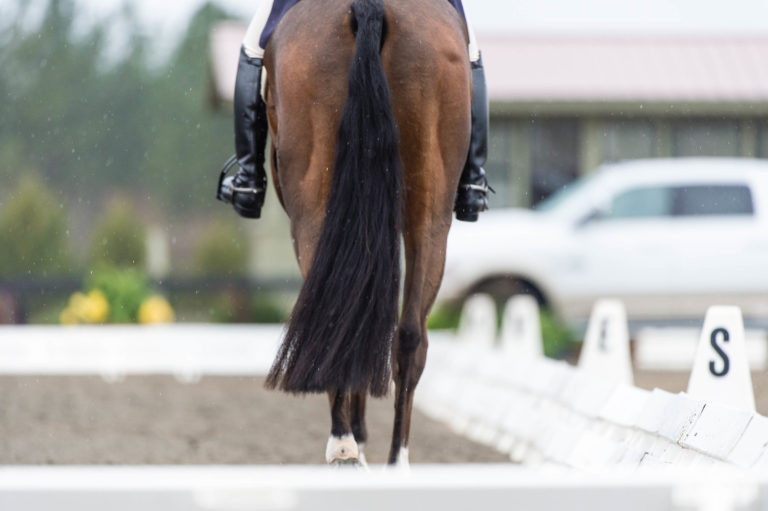When you observe the fetlock region of your horse, you may find a puffiness or fluid-filled area on the back side (palmar/plantar region) of his fetlock. This fluid-filled area may be what is referred to as a windpuff.
Windpuffs, or wind galls, are a result of fluid distention of the digital flexor tendon sheath (DFTS) and do not involve the fetlock joint itself. They typically have a bilateral presence in the hind limbs, although they may be present in all four limbs. The fluid distention of the DFTS caused by windpuffs is usually incidental and is not associated with discomfort or lameness.
The development of windpuffs is a result of accumulation of fluid in the DFTS. The DFTS serves a protective function, allowing frictionless movement as the tendons traverse the bony prominences of the fetlock joint. Over time, the repetitive gliding of the tendons over these bony surfaces can cause the naturally occurring fluid in the DFTS to increase. This can result in a puffy appearance to the DFTS—hence the term “windpuff.” Some owners wish to lessen the blemish for cosmetic purposes, but most treatments will only decrease the effusion for a few days, and it will most likely return to its enlarged state within a week or two.
Windpuffs can be observed in performance horses of all ages, but they are most common in older horses. Any horse in a consistent training program is a possible candidate to develop windpuffs, and most older horses who have had a long career in competitive sport have them. If a horse has bilaterally symmetric windpuffs with no associated lameness, heat, pain or history of injury to the DFTS, their presence is most likely without consequence. With that said, it is important to have any new swelling or effusion that is asymmetric examined by a veterinarian to determine if further diagnostics are necessary.
There is usually nothing you can do to prevent the formation of windpuffs. Even bandaging and sweats will only temporarily decrease the effusion, which will usually return a few hours after bandage removal. Once windpuffs have developed, there is rarely anything that can be done to correct them.
Conversely, tenosynovitis is a condition that causes increased fluid accumulation in the DFTS that mimics the appearance of a windpuff. It causes varying degrees of lameness as well as a positive flexion test. Ultrasound of the DFTS is necessary to evaluate all soft-tissue structures located within the DFTS and is a necessary diagnostic when tenosynovitis is suspected. MRI can also be useful to determine the extent of soft-tissue injury within the DFTS and is sometimes needed for accurate diagnosis. Treatment for tenosynovitis varies depending on the duration of inflammation and if any soft tissue structures are involved.
If your horse has developed fluid accumulation in the area of the DFTS, it is important to ask certain questions to help determine the possible long-term consequences. How long has the fluid distention been present? Is there a corresponding fluid accumulation that is symmetric on the opposite limb? Is the horse lame or is there any history of lameness? Is the horse positive to a flexion test of the distal limb? Has the DFTS had an ultrasound exam performed, and if so, what were the findings? All of these questions when discussed with your veterinarian may help determine if there is an active injury to the DFTS or if the fluid is a result of a windpuff. These questions are also useful when looking at horses to purchase who have fluid accumulation in the DFTS.
If the horse is determined to have windpuffs, it is most likely that they will not bother him in the long term. But in some cases, acute formation of windpuffs may warrant treatment to decrease the chance of lameness in the future.
Therefore, it is always important to consult your veterinarian to determine which course of action will be appropriate for your horse.
Courtney Varney, DVM, earned her B.S. in biochemistry at Stetson University in 2005 and graduated from the University of Florida College of Veterinary Medicine in 2010. She completed an internship at Ocala Equine Hospital and then worked at an equine practice in central Florida before returning to Ocala Equine Hospital as an associate in 2012. Her professional interests are sports medicine and lameness with a focus on regenerative-medicine therapies. She is a certified AERC veterinarian and is an FEI veterinary delegate for dressage and Para Dressage and an FEI treating veterinarian. A rider since childhood, she currently competes at the FEI level in dressage. She has received her USDF bronze, silver and gold medals and is currently competing at Grand Prix.











